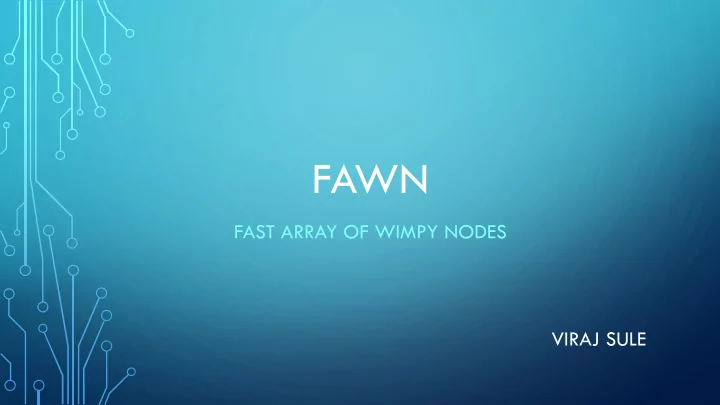

FAWN FAST ARRAY OF WIMPY NODES VIRAJ SULE
• FAWN is a cluster architecture for low-power data-intensive computing. • FAWN-KV is a consistent, highly available and high performance key-value storage system built over FAWN prototype.
(1) “The workloads these systems support share several characteristics: they are I/O, not computation, requiring random access over large datasets, they are massively parallel, with thousands of concurrent mostly independent operations and the size of objects stored is typically small. ” Read the above statement, indicate why workloads of these characteristics represent a challenge to the system design? • In I/O, CPU has to stall while waiting for data to be loaded or unloaded. • Random access over large datasets would be inefficient in case we need to access the data sequentially. • Size of objects is small then there will large amount of data; consequently, large metadata in terms of numbers. • Systems requiring large clusters includes DRAM which are expensive and consume large amount of power.
(2) “ The key design choice in FAWN-KV is the use of a log structured per-node datastore called FAWN-DS that provides high performance reads and writes using flash memory.” “These performance problems motivate log -structured techniques for flash filesystems and data structures” What key benefit does a log structured data organization bring to the KV store? • Log structured data organization provides with high write throughput because all the updates on data and metadata are written in sequential order in the log.
(3) “ To provide this property(Writes are sequential and Read is random access), FAWN-DS maintains an in-DRAM hash table (Hash Index) that maps keys to an offset in the append-only Data Log on flash. ” What are potential issues of the design? • Large number of key-value pairs will lead to large metadata. • As DRAM is volatile, the hash table will be lost once we turn OFF the cluster.
(4) “ It stores only a fragment of the actual key in memory to find a location in the log; ” Is there a correction concern in this design? • No • With the 15-bit key fragment, only 1 in 32,768 retrievals from the flash will be incorrect. • minor issue over drastically reduced memory requirements.
(5) “ Basic functions: Store, Lookup, Delete ” Use Figure 2(a) to explain how these basic functions are executed? • Store • It appends an entry to the log, updates the corresponding hash table to point this offset within the Data Log, and sets the valid bit to true. • Lookup • Retrieve the hash entry containing the offset, indexes into the Data Log, and returns the data blob. • Delete • Invalidates the hash entry corresponding to the key by clearing the valid flag and writing a delete entry to the end of data file.
(6) “ As an optimization, FAWN-DS periodically checkpoints the index by writing the Hash Index and a pointer to the last log entry to flash. ”. Why does this checkpointing help with the recovery efficiency? How is a KV item deleted from the store? • After a failure, FAWN-DS uses the checkpoint as a starting point to reconstruct the in-memory Hash Index quickly. • This can be done because Data Log contains all the information necessary to reconstruct the Hash Index from scratch.
References: • FAWN paper • http://muratbuffalo.blogspot.com/2011/02/chain-replication-for-supporting- high.html • Lectures Slides
Recommend
More recommend